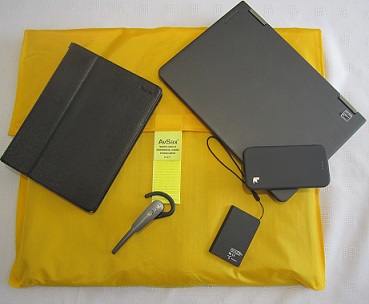 An AvSax with some of the personal electronic devices it is designed to deal with should they catch fire
An AvSax with some of the personal electronic devices it is designed to deal with should they catch fire
An award-winning fire containment bag has been deployed to deal with emergencies on board aircraft way more than any of its rivals.
Latest figures reveal that 65 airlines ranging from major carriers to budget companies across the world now carry AvSax bags that contain lithium-ion battery fires on board planes.
And they have been used to deal with emergencies sparked by fires in passengers’ electronic devices ranging from mobile phones to laptops 28 times since January 2017.
That’s four times more than its closest rival which has been deployed just six times.
It also means 13,500 AvSax are on aircraft worldwide. It was deployed as recently as early November on a transatlantic flight when a passenger dropped his eReader down into the seat mechanism and subsequently moved the seat which damaged the eReader. The battery overheated and the case started to melt, causing smoke to pour from the device. Cabin crew doused the fire and put the eReader in an AvSax.
The AvSax were invented and are manufactured by Environmental Defence Systems Ltd based in Huddersfield, West Yorkshire, which received the prestigious Queen’s Award for Innovation 2018 for the pioneering bag.
Some of the world’s best-known and biggest airlines have AvSax which they have needed to use in real-life emergencies.
AvSax sales director Richard Nikolic said: “The AvSax are there to protect the passengers and they have been used in action several times now which has shown just how necessary they are. It also shows the airline industry has confidence in the product.”
The fires are caused by lithium-ion batteries going into what is known as thermal runaway inside electronic devices ranging from mobile phones to laptops carried on board by passengers.
When one cell in a battery overheats it can produce enough heat – up to 900°C (1652°F) – to cause adjacent cells to overheat. This can cause a lithium battery fire to flare repeatedly.
Incidents of thermal runaway are on the rise.
Lithium-ion battery fires on board planes are rarely publicised but a fire in a device could emit toxic smoke and potentially the battery may even explode, causing damage to the aircraft and putting lives at risk.
There are many cases where lithium-ion battery fires have caused planes to be diverted as an emergency and the average cost of that in the USA is $400,000.
Mr Nikolic added: “AvSax is the result of many years of development, drawing on experience from the production of an alternative sandbag we invented called a BlastSax designed for the military to reduce the impact of fragmentation generated by small improvised explosive devices.
“The danger is that with so many poor quality and fake batteries around there is no doubt that incidents will continue to happen. The fact that AvSax have been deployed so many times shows there is a real need for this product. Any fire on board a plane is a frightening prospect but the AvSax has proved itself in action time and time again.”
A recent estimate revealed that aircraft carrying just 100 passengers could have around 300 to 500 lithium batteries on board when you tot up all the laptops, cameras, e-readers, tablets and mobile phones that need them. There is always a possibility that poor quality or damaged batteries can overheat, causing them to go into thermal runaway which could lead to the device catching fire.
The Federal Aviation Administration (FAA) in the USA has reported 191 fires between 1991 and January 2018 from lithium batteries carried on-board aircraft as cargo or baggage. Ominously, of those, 46 were reported in 2017.
How do AvSax work?
If an electronic device starts to seriously overheat or emit smoke the cabin crew will pour at least two litres of water into an AvSax. It is imperative to first knock down the flames from the device using an on board halon fire extinguisher, then transfer the device into AvSax before it reignites. Additional water is then required. The water activates the polymer gel inside the bag causing it to expand around the device. Should the device keep on venting then the AvSax is tough enough to absorb the energy.
The AvSax cools the batteries in the device, reducing the likelihood of the battery igniting but if it does go into thermal runaway it is all contained within the bag.
Amazingly, the water is absorbed into the internal lining of the bag so the device is dry when it is removed.
* Written by Andy Hirst at AH! PR http://www.ah-pr.com/